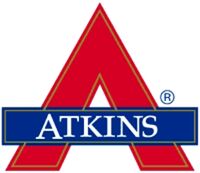
About[]
The Atkins diet involves limited consumption of carbohydrates to switch the body's metabolism from metabolizing glucose as energy over to converting stored body fat to energy. This process, called ketosis, begins when insulin levels are low; in normal humans, insulin is lowest when blood glucose levels are low (mostly before eating). Reduced insulin levels induces lipolysis which consumes fat to produce ketone bodies. On the other hand, caloric carbohydrates (for example, glucose or starch, the latter made of chains of glucose) affect the body by increasing blood sugar after consumption. (In the treatment of diabetes, blood sugar levels are used Carbohydrate Counting.) Fiber, because of its low digestibility, provides little or no food energy and does not significantly affect glucose and insulin levels.
What You Can Eat[]
The Atkins diet has evolved since its creation in 1972. But the main feature of the diet is still the same: Lose weight and improve health by eating a low-carbohydrate diet that consists of:
Protein, Vegetables, and Healthy fat. The diet has an Atkins Food Guide Pyramid that helps explain the Atkins method. At the top of the pyramid are foods that you can eat a little of -- but only after you have lost weight. These include whole grains such as:
Barley, Oats, and Rice. Missing from the Atkins Food Pyramid are "white" foods -- forbidden foods that you should avoid. These include:
White sugar, White rice, White bread, White potatoes, and Pasta made with white flour. You don't have to count calories on the Atkins diet as long as you are reasonable with your portions. The only thing you have to calculate are carbohydrates. Specifically you need to count Net Carbs -- the total grams of carbohydrates minus grams of fiber.
Phases[]
The Atkins diet consists of phases. The amount of Net Carbs you eat each day varies based on the phase.
Phase 1 -- Induction. This is the strictest part of the diet. You must avoid all:
Fruit, Bread, Grains, Starchy vegetables, Dairy products (except cheese and butter), Alcohol. You eat only 20 grams of Net Carbs daily. That's significantly less than the FDA recommendation of 300 grams of carbohydrates daily.
The goal of phase 1 is to rev up your body's ability to burn fat. And because you lose the most weight during this phase, it is designed to motivate you to stick with the diet.
Phase 2 -- Ongoing weight loss (OWL). During phase 2, you slowly add some whole food carbohydrates back to your diet, such as:
Berries, Nuts, Yogurt. You can eat between 25 and 45 Net Carbs daily. Phase 2 lasts until you are about 10 pounds from your desired weight.
Phase 3 -- Pre-maintenance. During phase 3 you continue to add a variety of carbohydrates to your diet, including more:
Fruits, Starchy vegetables, and Whole grains. You can eat 50 to 70 Net Carbs daily. Phase 3 lasts for at least a month after reaching your desired weight.
Phase 4 -- Lifetime maintenance. Once you reach your ideal weight, you continue to eat a predominantly low-carbohydrate (75 + Net Carbs per day) diet for life. By this time, you should have a good idea of how many carbohydrates you can eat to maintain your weight.
Source: WebMD